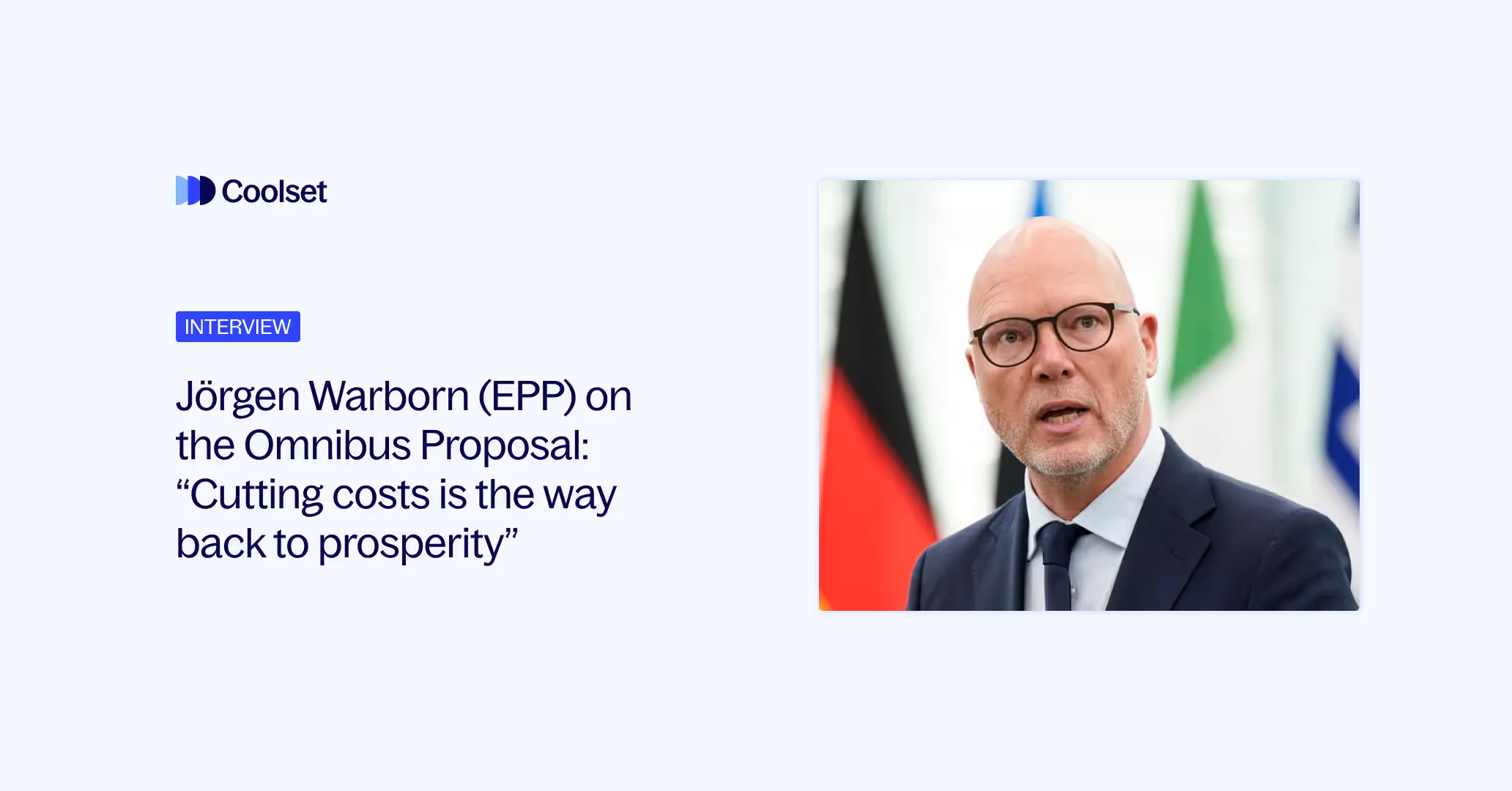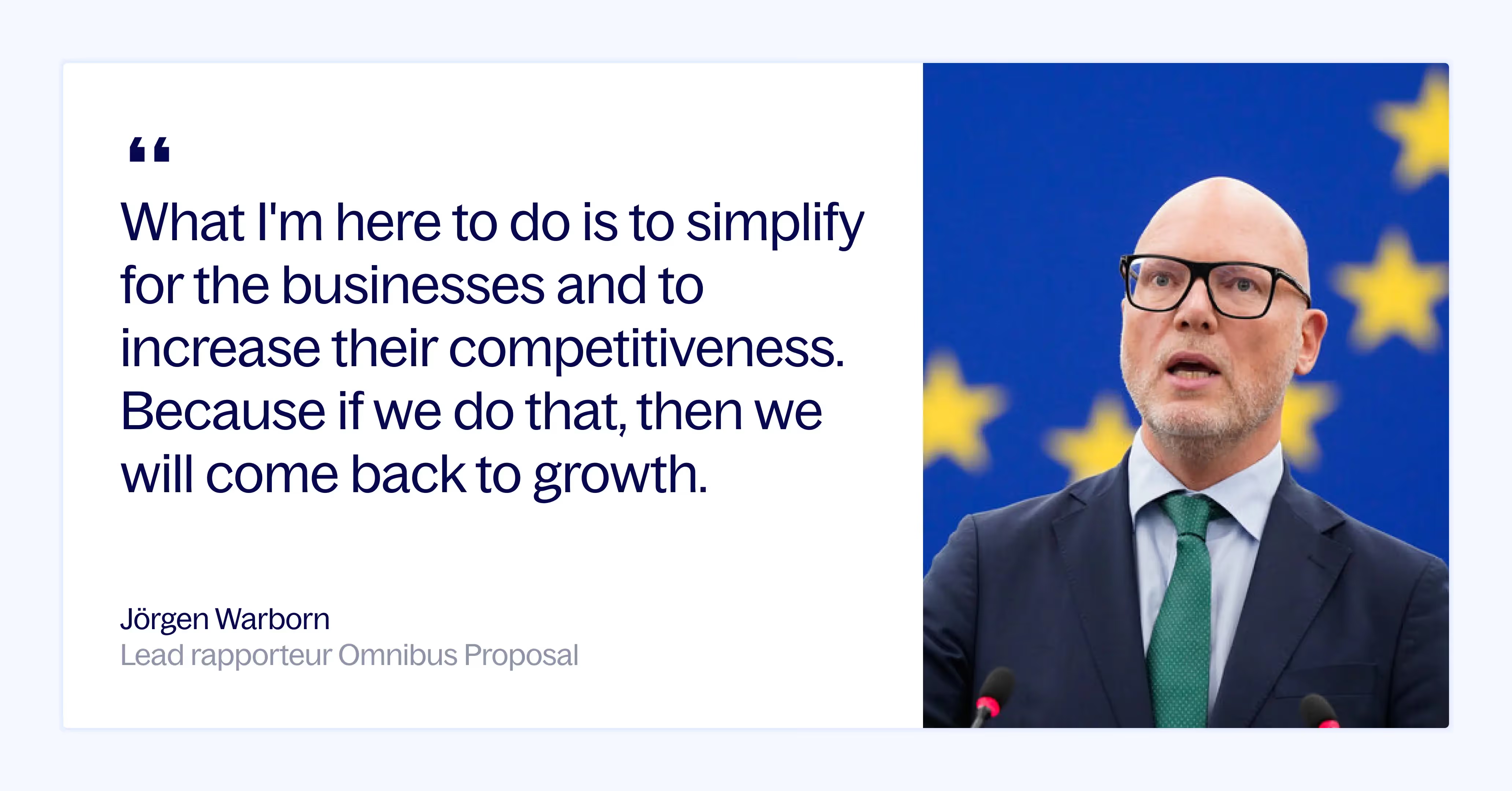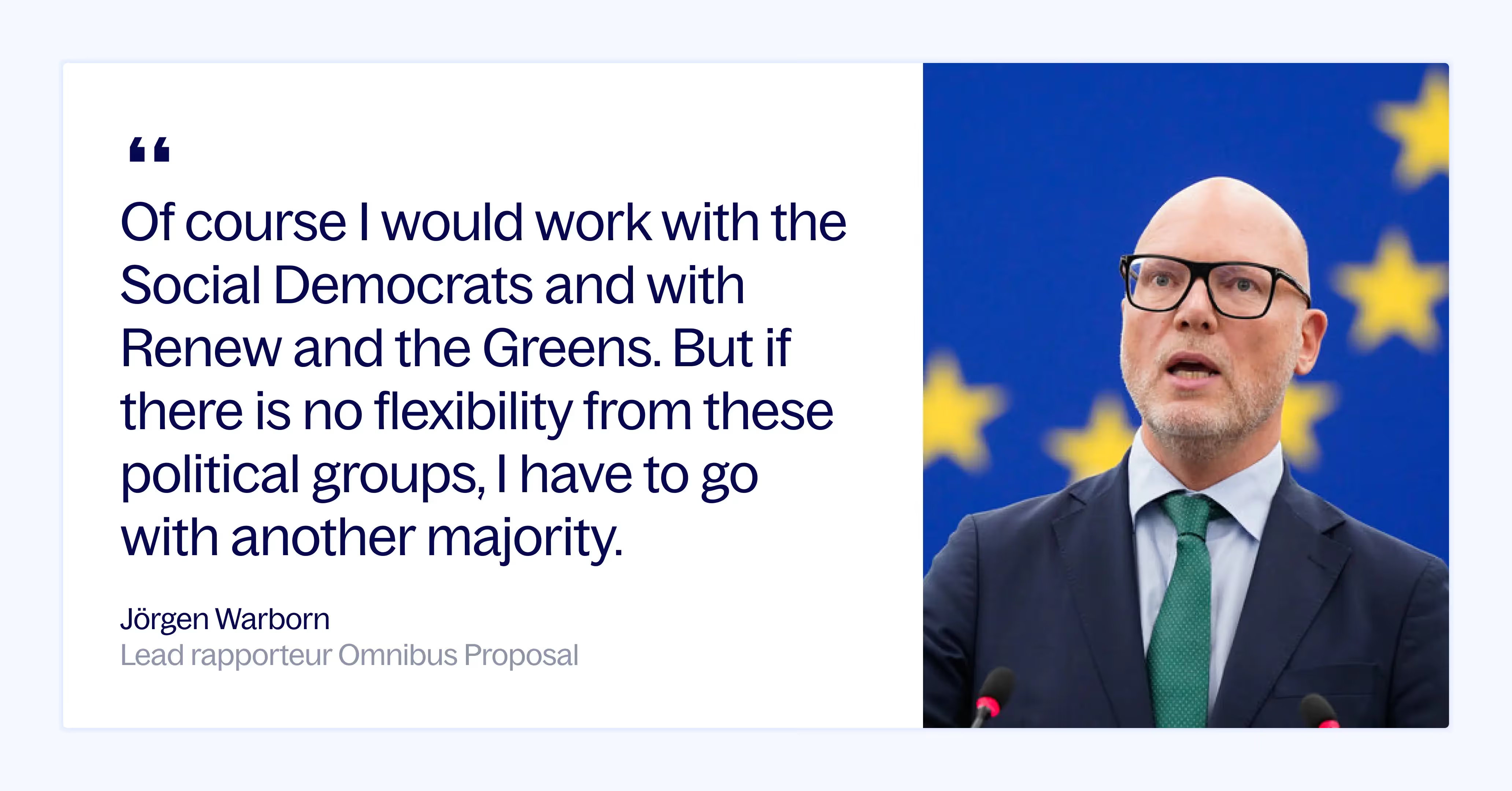
Disclaimer - EUDR updates as of 23rd September 2025
On July 9, the European Parliament rejected the EUDR country risk benchmarking system. More recently on September 23, the European Commission also proposed delaying the regulation’s implementation. We are monitoring these developments and will update content as needed. For the most up-to-date information, refer to this deep-dive article.
Disclaimer: Latest EUDR developments
While earlier discussions pointed to a one-year postponement of the EUDR, the latest Euractiv report suggests the delay would apply only to small and micro operators.
The main compliance deadline of 31 December 2025 remains unchanged for most operators and traders. In-scope companies should now accelerate supplier mapping, traceability, and due diligence documentation to stay on track. Read more about the latest developments here.
Key takeaways:
As lead rapporteur for the European People’s Party (EPP) on the Omnibus Proposal, Jörgen Warborn is one of the most influential figures shaping the future of sustainability regulation in Europe. His draft report proposes sweeping changes to the Corporate Sustainability Reporting Directive (CSRD), including raising the reporting threshold to companies with over 3,000 employees – a move that would exempt the vast majority of firms currently in scope.
For Warborn, it’s a question of economic survival. “We are falling behind most of the other global players when it comes to growth,” he says. His solution: reduce the regulatory burden, simplify requirements, and restore what he sees as a necessary balance between environmental, social, and economic priorities.
Warborn’s position has made him a central – and polarizing – player in the debate over Europe’s sustainability agenda. Supporters see pragmatism. Critics see backsliding. But few dispute his influence.
We spoke to him in Brussels to understand how he’s approaching the negotiations, what’s driving his push for simplification, and how far he’s willing to go to build support for a new direction.
At the heart of his argument is competitiveness – not just as an economic metric, but as a political tool. “What I'm here to do is to simplify for the businesses and to increase their competitiveness,” Warborn tells us. “Because if we do that, then we will come back to growth and that will give us long-term prosperity in Europe.”
Warborn is quick to point out that the goal isn’t deregulation for its own sake. “Cutting costs in itself is not the key goal,” he adds later. “That is prosperity for European citizens. And we have to come back to growth.”
While others frame sustainability as a long-term investment, Warborn frames it as a balancing act – and for now, his priority is clear.

Warborn’s argument is that too many climate and social targets have been layered on top of businesses too quickly, without enough attention to feasibility or cost. “We need to change a few things,” he says. “And one of the things is, of course, the regulatory burden.” For him, the Omnibus is an opportunity to recalibrate – away from what he called “a lot of green, but not always the deal,” and toward a version of sustainability that gives equal weight to economic realities.
He frequently returns to the idea of balance: between environmental goals, social concerns, and economic survival. But his emphasis on growth is not just rhetorical – it drives the structure of his proposals, from raising thresholds to simplifying data requirements. Whether that balance is widely shared in Parliament remains to be seen, but Warborn’s position is clear: restoring growth comes first, and the rest will follow.
“I think there are gains in terms of competitiveness of working with sustainability issues,” Warborn says. “I’m quite certain of that.”
Still, he questions the role of government in setting the pace. “The issue for me is rather what should the market solve in this, and what should politicians solve in this?”
He points to regional differences within the EU. “A lot of Swedish companies have been doing great work on sustainability issues,” he says. “If you compare to the rest of Europe, there are some cases where some of the other member states are a bit behind the Nordic countries.”
“And that’s also why we cannot create a directive, which I think we did with CSDDD and CSRD in a sense – CSDDD especially – where we put up the golden standard of it and we expect everyone to work on that golden standard. We first have to make sure that we get everyone on board.”
“That’s what we’re trying to correct now,” he continues, “making sure that it’s feasible for all the businesses to start that journey that some companies did 10, 15, 20, 25 years ago. But we cannot have the highest expectations of them in the first place. And that’s where we went wrong.”
When asked why the Omnibus Proposal doesn’t concentrate on simplifying the CSRD rather than removing companies from its scope, Warborn is clear: both approaches are on the table. “I agree, I agree,” he says. “But you can do both, because if your main objective is to cut costs, you do both, and you cut more costs.”
“So you change the scope and you simplify the data points,” he continues. That dual approach, he argues, is what makes his proposal effective. “And that’s the intention here – to do both.”
Asked directly about the consequences of raising the threshold to 3,000 employees, Warborn doesn’t hesitate. “Exactly. So you save even more money.”
Still, his emphasis remains on the cost-cutting rationale rather than the long-term impact on implementation. “This is not science,” he says. “It’s 250, it’s 500, it’s 1,000, 3,000, 5,000, 10,000. What is the right number?” For him, it’s not a question of principle, but of where the biggest savings can be made. “Now we're going to find the balance,” he says. “And I have found it. It’s 3,000.”
Warborn is clear about his priorities. “That’s why my line is cutting costs,” he says. “I don’t mind the language of deregulation. It’s about cutting costs.”
He’s aware of the political baggage the term carries. “There is a sensitivity with the word deregulation, I understand,” he acknowledged. “But some use it and some don’t. Some say less bureaucracy, cutting red tape, simplification. For me, we can use any language. It doesn’t really matter.”
His goal, he says, is not ideological. “What I'm here to do is to simplify for the businesses and to increase their competitiveness,” he says. “Because if we do that, then we will come back to growth and that will give us long-term prosperity in Europe.”
European Commissioner for Economy and Productivity, Valdis Dombrovskis, struck a more cautious tone when presenting the Commission’s simplification package. “This simplification agenda is not about deregulation,” he says. “It is about achieving our goals in a smarter and less burdensome way, so that our companies, and especially our SMEs, can focus on growth, jobs, innovation, and helping us secure the green and digital transitions.”
For Warborn, the language matters less than the outcome. “We need prosperity in order to solve a lot of the issues we have on the table at the moment,” he says – including defense, social stability, and climate.

“There's 800 amendments on the table,” Warborn says. “How do you go about that?” For him, the answer starts with pattern recognition. Not every amendment carries equal weight. “In some cases, there is only one or two that have signed it, and that gets less attention,” he explained. “But if you have a lot of people on some issues, then you understand that there is traction in this issue, and that’s why we have to put focus on it.”
The committees offering opinions on the proposal – like ECON and the legal affairs committee – are also playing a strategic role. “That's a good basis as well,” he says. “Because there you have different majorities. In ECON, we had a majority to the right of us, but in the rest, we had a broader majority.”
Those shifting coalitions suggest that no single alliance will determine the outcome. Instead, Warborn is looking for where enough overlap exists to land a deal. “This is where you have to find the balance,” he says. “That is one of the most important parts for the next step.”
Warborn describes his approach to negotiations in simple terms: flexibility first. “I have no red lines,” he says. “But I have an interest: cutting costs.”
That interest, he explained, shapes how he engages with other political groups. “I'm prepared to negotiate on all those points, as long as we cut costs. So I'm prepared to give in, but I also have to receive on the other end when there is a negotiation.”
He sees this openness as a strength, not a compromise. “A very constructive way of dealing with this – is to be open to what matters to the other groups.” He distinguishes between fixed positions and shared objectives: “I don't have clear positions, but I have clear interests.”
Pressed on whether some limits are necessary, he conceded that they may emerge eventually – but not up front. “At the end of everything, you have to say, okay, I cannot cross this line of this and this reason,” he says. “But starting the position with red lines – and especially mentioning them in the media – I’m not really sure that that is the clever way to do negotiations.”
Instead, he aims to “listen to the other political groups and see where we find the common lines.” Because in his view, “it's with the common lines we build a majority. And that's the important stuff.”
One of the few points of early consensus on the Omnibus Proposal was a commitment – at least in principle – between the European People’s Party (EPP), the Greens, the Socialists and Democrats (S&D), and Renew Europe to find a shared position. But Jörgen Warborn doesn’t see that alignment as essential to getting the proposal through.
“I don't exclude working with other groups either,” he says. “Because if I wouldn't, then negotiations would be very hard.”
While others see the centrist coalition as necessary to preserve ambition, Warborn keeps the door wide open. “Of course I would work with the Social Democrats and with Renew and the Greens,” he says. “But if there is no flexibility from these political groups, then I have to go with another majority.”
What kind of majority that would be, he doesn’t specify. “That will be shown in the negotiations, of course,” he says. But he made clear that looking further right is a possibility. “If you get some of those groups together and some of them are to the right of us, well…”
His goal, he says, isn’t to protect a coalition. It’s to deliver on his mandate. “My goal is to cut costs for businesses,” he says. “And I’ll find the majority to do it.”

Warborn describes his role as rapporteur in pragmatic terms. “You have, of course, a strong political idea of what you would like to do,” he says. “But in your role, you’re trying to bridge the gap and find creative ways of delivering to the other political groups what they need to support the agreement.”
That, he says, requires flexibility – and a fair amount of improvisation. “Creativity,” he says simply, when asked what people might not expect from the job.
With over 800 amendments on the table, finding common ground is less about holding fixed positions and more about understanding which compromises unlock support. “If I know the other political groups – what interests they have – then we try to combine the interests and find a win-win situation,” he says. “Then we can massage the text in a way that helps give every political group something.”
The legislative process is now moving quickly, with negotiations and key decisions scheduled over the coming months. Here’s how the timeline currently looks:
As the timeline accelerates, Warborn’s influence will only grow. With over 800 amendments on the table and weeks of shadow meetings ahead, his ability to broker compromise across political lines will be central to shaping the final outcome.
Whether his push for simplification and cost-cutting prevails – or is tempered by competing priorities – will be decided in the coming months. But one thing is clear: the next phase of negotiations will test not just the proposal, but the political coalition behind it. And Warborn is determined to lead it through.